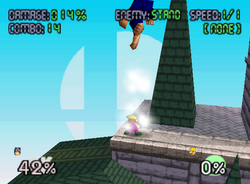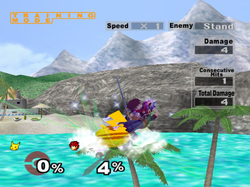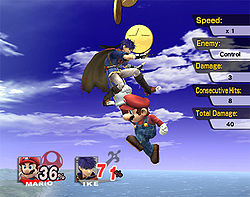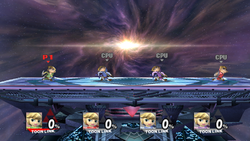Training Mode: Difference between revisions
m (→Character Loading Input Delay: Um, source?) |
The Gamer 91 (talk | contribs) m (Minor Improvements.) |
||
| Line 1: | Line 1: | ||
{{ArticleIcons|ssb=y|melee=y|brawl=y|ssb4=y}} | {{ArticleIcons|ssb=y|melee=y|brawl=y|ssb4=y}} | ||
[[File:SuperSmashTraining.png|thumb|250px|The Training Mode in ''[[Super Smash Bros.]]'']] | [[File:SuperSmashTraining.png|thumb|250px|The Training Mode in ''[[Super Smash Bros.]]'']] | ||
[[File:Super Smash Bros. Melee Training mode.png|250px|thumb| | [[File:Super Smash Bros. Melee Training mode.png|250px|thumb|Training Mode in ''[[Super Smash Bros. Melee]]''.]] | ||
[[File:Training.jpg|thumb|250px|Training Mode in ''Brawl''.]] | [[File:Training.jpg|thumb|250px|Training Mode in ''[[Super Smash Bros. Brawl]]''.]] | ||
'''Training Mode''' ({{ja|トレーニング}} ''Torēningu'', simply '''Training''' in ''Brawl'') is a mode available in all four games where the player can manipulate overall gameplay of a match and experiment with the CPU without the restrictions of a standard match. Making its debut in ''[[Super Smash Bros.]]'', both ''[[Super Smash Bros. Melee]]'' and ''[[Super Smash Bros. Brawl]]'' made improvements to the mode. | '''Training Mode''' ({{ja|トレーニング}} ''Torēningu'', simply '''Training''' in ''Brawl'') is a mode available in all four games where the player can manipulate overall gameplay of a match and experiment with the CPU without the restrictions of a standard match. Making its debut in ''[[Super Smash Bros.]]'', both ''[[Super Smash Bros. Melee]]'' and ''[[Super Smash Bros. Brawl]]'' made improvements to the mode. | ||
Revision as of 21:17, October 2, 2014



Training Mode (トレーニング Torēningu, simply Training in Brawl) is a mode available in all four games where the player can manipulate overall gameplay of a match and experiment with the CPU without the restrictions of a standard match. Making its debut in Super Smash Bros., both Super Smash Bros. Melee and Super Smash Bros. Brawl made improvements to the mode.
Overview
As implied by its name, Training Mode is intended to allow players to use characters in a non-serious setting; all matches within the mode are actually Time matches of infinite length, as seen on the Jumbotrons featured in the Pokémon Stadium stages and with the Pokémon Trainer's comments when using Pokémon Change.
Unusually, the Stale-Move Negation is not present in the mode for Brawl.
Overlay
Within the training mode, a specialised overlay, unavailable in any mode, is displayed on the screen in order to show data relevant to gameplay. The overlay is always present in Smash 64 and Melee, but is disabled by default in Brawl.
The overlay contains information regarding:
- Speed: Shows the speed at which the game is running at.
- Enemy: Shows the behaviour set by the player for any CPUs in play.
- Damage: Displays amount of damage most recent attack inflicted by the player.
- Combo/Consecutive Hits: Renamed for Melee and Brawl, this displays how many hits the player has attained on the opponent in one standard combo; this data is saved, with the longest combo done by an individual character being displayed on the character selection screen for the mode. The counter in the overlay will top out at 999, though the mode can display higher combos on the character select screen
- Total Damage: Added in Melee, this displays how much damage the present combo has done on opponents. Like the Combo counter, it maxes out at 999.
Available modifiers
In addition to allowing players to train against an ordinarily idle opponent or to perfect their timing in combos or other advanced techniques, the player has the option of manipulating the environment of the stage or gameplay. Initially limited in Smash 64, modifiers within Melee and Brawl were more advanced.
- Speed: Allows the player to alter the gameplay speed of the match, though some aspects of gameplay, such as transformation Final Smashes like Wario-Man and stage hazards like the lava in Brinstar, are unaffected by this setting. The original game allows for standard speed, as well as factors of two-thirds, one-half, and one-quarter; Melee added factors of one-and-a-half and two, though the lattermost was later removed for Brawl
- Item: Allows player to spawn an item of their choice on the stage. As the pause menu does not stop gameplay, items can interact with the environment while the stage is paused.
- CP/CPU: Modifies the behaviour of the computer-controlled players. The following behaviours are available:
- Stand/Stop: Forces the CPU to stand still, as well as not input any directions upon being hit; the CPU will still recover should they be knocked off the stage.
- Walk: Causes the CPU to walk back and forward on the stage. Upon encountering obstacles that it cannot traverse, the CPU will reverse directions.
- Evade/Run: Causes the CPU to actively avoid the player.
- Jump: Causes the CPU to constantly jump.
- Attack: Causes the CPU to act as it would in an ordinary match. Brawl gave the ability for players to decide how strong they want the CPU to be.
- Control: Allows the player to control CPUs with extra controllers. Added in Melee.
- No. of CPUs: Allows player to decide on how many CPUs to include in a match. Introduced in Melee, the player can spawn one, two, or three bots, though they will all be the opponent selected prior to the match. If "Attack" or "Control" is selected for their behaviour, they will not be harmed by each other's attacks.
- CPU Damage: Changes the damage all computer-controlled opponents have. Can be anywhere from 0 to 999, but pausing the game to modify other values will reset damage to the value set.
- Camera: Allows player to modify how the Camera looks at the stage. Smash 64 allows for "Normal" and "Close-up", the latter of which zooms in on the player; Melee adds a "Free" option that zooms in the camera as well, but to a lesser extent than the renamed "Zoom" option. Brawl removed the "Free" option.
- Reset: Resets the stage and sends all characters back to their original spawn points. All items are removed from play, and the stage returns to its original form; damage percentages are also reset.
- Exit: Sends the player back to the character selection screen.
Rewards
In Melee
- Getting an 11 hit or higher combo will grant the player the Metal Box trophy.
- Getting a 21 hit or higher combo will grant the player the Lip's Stick trophy.
- Getting a total of 125 combined combos will grant the player the Bunny Hood trophy.
In Brawl
- Getting a 10 hit combo will grant the player the Banana Peel trophy
- Getting a total of 400 combined combos will grant the player the Ouendan trophy.
Character Loading Input Delay
In Brawl, after adding additional CPU's to a match, those CPU's do not function correctly when set to Control. It is unclear exactly what causes it, but they do not act on the same frame as another character using the same input, causing both input delays and ignored inputs. Opening and closing the training menu (by pressing the pause button) fixes this until a new CPU is added. This does not occur in Melee.
Trivia
- In Super Smash Bros., the background of each stage is changed to the Super Smash Bros. emblem and the music for each stage is changed to the Training Mode theme.
- In Super Smash Bros. Melee, the most recent Pokémon to be unleashed from a Poké Ball will either be the second Pokémon that appears in a standard Versus match, or the first in a Single Player mode.
- In Melee, the maximum number of consecutive hits that the game can record is 32,767. This irregular value can most likely be explained by binary data storage, as it's equal to 215 – 1.
| Super Smash Bros. Brawl menu items | |
|---|---|
| Group | Brawl (Time · Stock · Coin Battle · Team Battle) · Rules · Special Brawl · Rotation · Tourney · Names |
| Solo | Classic · All-Star · Adventure Mode: The Subspace Emissary · Events · Stadium (Target Smash!! · Home-Run Contest · Multi-Man Brawl · Boss Battles) · Training |
| Wi-Fi | Spectator Mode · With Anyone · With Friends |
| Vault | Trophies & Stickers (Trophy Gallery · Trophy Hoard · Coin Launcher · Sticker Album · Sticker Center) · Stage Builder · Album · Challenges · Replays · Masterpieces · Chronicle |
| Options | Screen · Deflicker · Rumble · Controls · Sound · My Music · Erase Data |
| Data | Movies · Records (Group Records · Brawl Records · Notices) · Sound Test |



